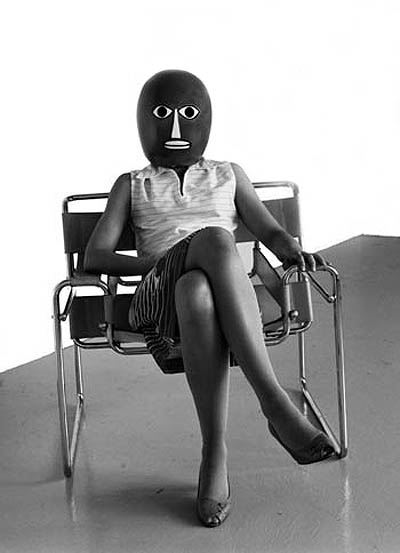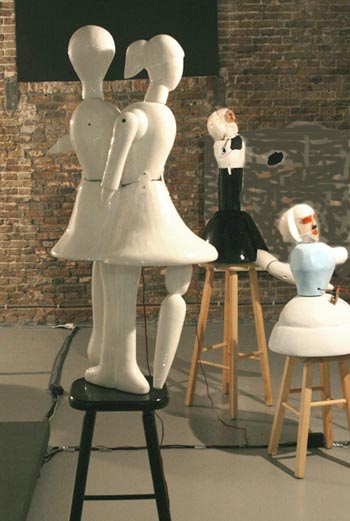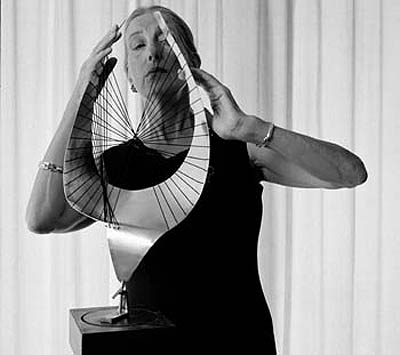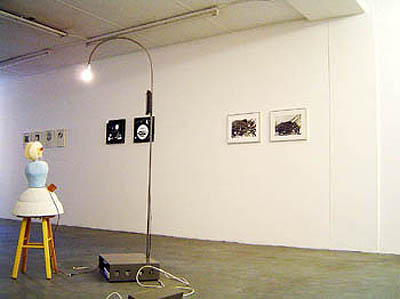
_______________________________________________________________
Frauhaus, Ursula Mayer, Untitled Triptych, Screenprints on silver paper, framed,
2006
_______________________________________________________________
 ... ...
_______________________________________________________________
Frauhaus, Gal Kinnan, Ccmputer controlled sculptures, 2006
_______________________________________________________________

_______________________________________________________________
Frauhaus, Ursula Mayer, Videostill, 2006
_______________________________________________________________

_______________________________________________________________
Frauhaus Installation View , 2006
_______________________________________________________________
|
_____________________________
Frauhaus, 2006
curated by Ken Pratt
Sadie Murdoch, Gal Kinnan, Ursula Mayer,
Heidi Kilpelainen,
Karen Tang, Angie Reed
____________________________________
In recent years there seems to be a trend for a number of contemporary artists to engage with images, ideas and concepts of twentieth century Modernism. The canon of modernist aesthetics and approaches has once again bubbled to the surface as these artists engage with a range of historical sources ranging from Constructivism and Bauhaus to modernist architectural and design movements.
Major institutions and commercial spaces have presented works by a younger generation of artists that directly reference or engage in the heritage of Modernism. And once again, perhaps ironically given some of the discourses constructed by women artists working in this area, it has primarily been the male Young Turks who have gained recognition and acclaim.
“Frauhaus” seeks to provide a certain balance by reviewing the work of a number of women artists –some of them young, others emerging or established- who have also been engaged with addressing the heritage of Modernism and its substrata in their recent practice. And, it does so from a conscious position of a “salon review” or snapshot: these artists are not isolated in engaging with the topic. The strand is increasingly visible in the work of others. For example, American artist Sue de Beer will present a new project tackling the subject in collaboration with curator Jan van Woensel later this year at MUHKA in Antwerp; Pil and Galia Kollectiv, already engaged with the aura of Modernism for years, recently presented a new work directly referencing Schlemmer and experimental rock music at The Showroom in London; Micahela Meise addresses the intersections of performance and visual aesthetics arising from European mid-century modernist movements and reconfigures them in a context after Minimalism and Conceptual Art. The presented artists are not working in a vacuum.
The work in “Frauhaus” itself is varied with the individual artists often taking very different approaches or focusing on specific concerns. However, it is hardly surprising that one overarching thematic that seems to run through much of this practice is some kind of attempt to address the gender politics of Modernism in an art historical context. To reduce the practices of these individual artists to a simplistic statement of their concerns being those of gender and identity politics within a trope that reassess modernist aesthetics would unreasonable: each artist has her own additional aims and intentions in her work and the gender politics are present in greatly varying degrees.
Nonetheless, these artists are acutely aware of the lack of a female aura in the Gropius villa in the coffee table books of suburbia. In some cases they appear to be demanding direct redress for the way in which art and design history has sidelined the role of women in these key twentieth century movements and yet in others -almost a contradiction- they appear to be acknowledging the fact that the narratives of twentieth century modernist production were amongst the first to allow a role for women as creators. If the stories we tell about the Bauhaus and Constructivism are a little fishy from a feminist perspective, they nonetheless are amongst the first in which women are accorded some credit.
The women graduates of the Bauhaus or theatre designers of Russian revolutionary theatre may have been assigned a number of traditional gender roles. However, it might be some indication of progress within its own historical context that -even if they are shown in marcel waves and frilly dresses besides pipe-smoking men in baggy woolen suits- they appeared in increasing numbers on the group graduation photographs of these movements. Unlike many of their preceding counterparts, they had faces and names that could speak to more recent generations of artists about their identities and work.
In some cases, the work of the artists shown in “Frauhaus” appear to be engaged in a complex intellectual discussion about the role of women in these movements. In the case of others, they appear to be fairly straightforward starting points or sources of inspiration for far more personal or quirky discourses; the historical women and their work speak for themselves and require no justification.



|
 |
 |
